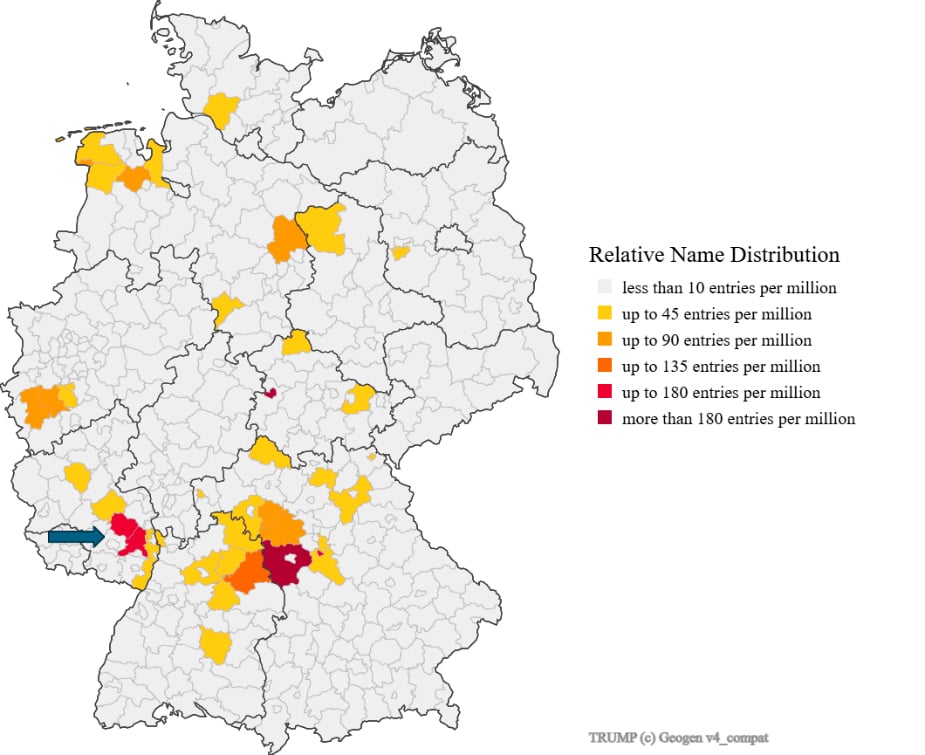Introduction
The surname "Trump" has intrigued researchers and historians alike, given its strong ties to German heritage and its rise to prominence in the United States. Rooted in medieval German linguistics, the name carries occupational and symbolic significance tied to music and social hierarchy. This article explores the historical and linguistic origins of the surname, tracing its evolution through the centuries and its association with specific professions, regions, and families.
Linguistic and Historical Origins
The surname Trump derives from the Middle High German "trump(e)", meaning trumpet, trombone, or occasionally drum. This etymology suggests a strong connection to occupations involving these instruments. In medieval and early modern Germany, trumpeters and trombonists held esteemed positions in society. Jurgen Udolph emphasizes the multifaceted roles these individuals played:
- Military Communication: Trumpeters conveyed commands across large distances during battles, serving as essential components of military strategy.
- Urban Administration: In towns and cities, trumpeters were employed in civic towers to play signals, marking time or warning of impending danger.
- Cultural Significance: As musicians, they contributed to religious ceremonies, festivals, and other community events.
These professions were highly respected and often well-compensated, reflecting the societal value placed on their skills.

Iconographic evidence indicates that trumpets in early medieval Europe were straight, with curved designs emerging around the 14th century. By the late Middle Ages, the long trumpet with a single coil became the standard, evolving into the Baroque trumpet, which remained largely unchanged until the 18th century. The mastery of the clarino register (high range of natural tones) was considered a hallmark of Baroque trumpet performance, underscoring the skill and societal status of trumpeters. The term "Drometten", documented in 1470 in Pirna, and "Drommete," used by Martin Luther in his Bible translation (Isaiah 18:3), highlight the linguistic evolution of the word.
Occupational and Symbolic Significance
From the late medieval period through the Baroque era, the trumpet served as a symbol of power and authority. Trumpeters held highly esteemed positions, often as official representatives of rulers or religious institutions. They were more than mere musicians; they were state officials, tasked with performing at ceremonies and issuing commands in military contexts. Only on rare occasions, such as major religious celebrations, were trumpeters permitted to collaborate with other musicians for non-official purposes. The cultural and social prestige associated with trumpeters reinforced their importance in medieval and early modern society, which is reflected in the etymological legacy of the surname "Trump."

Family History and Regional Context
The Trump family's historical connection to the Rhineland-Palatinate region, particularly the villages of Kallstadt and Bobenheim am Berg, provides critical insights into the name's development. According to archival research by journalist Kate Connolly, the surname "Trump" is documented in Kallstadt only from the 19th century onward. Variants such as Drumb, Tromb, Tromp, Trum, Trumpff, and Dromb were recorded, reflecting the fluid spelling conventions of the time.
Johannes Trump, born in 1789 in Bobenheim am Berg, moved to Kallstadt in the early 1830s, where he established himself as a vintner. His grandson, Friedrich (Frederick) Trump, born in Kallstadt in 1869, later emigrated to the United States and became the grandfather of Donald Trump. The Trump family's association with winemaking persisted in Kallstadt, a village located in the Pfalz wine region, where many of their descendants remained vintners.
Johannes Trump's sister, Charlotte Louisa, married Johann Georg Heinz, whose son Johann Heinrich (John Henry) Heinz emigrated to the United States in 1840. John Henry's son, Henry J. Heinz, founded the H.J. Heinz Company, making him a second cousin of Frederick Trump. This intertwining of the Trump and Heinz families underscores their shared German-American heritage.

The Trump family's German roots, including their Lutheran faith, were long concealed by Donald Trump's father, Fred C. Trump, who grew up in a predominantly German-speaking environment but distanced himself from this identity during his adulthood.
Patrilineal Lineage
The earliest known patrilineal ancestor of the Trump family is Johann Philipp Trump, also referred to as Hanss Philipp Trump (c. 1677–1707), from Ellerstadt, who married Maria Juliana Rodenroth (b. 1668) on 1695, January 18, in Battenberg.

They had 6 children. However, the genealogical connection to any anterior Trumps or even Drumpfs remains unsourced. Contrary to some claims - such as those by journalist Gwenda Blair - that the family name was once spelled "Drumpf," Udolph clarified that this spelling occurred only once and is not representative of the family's consistent nomenclature. There are no birth or christening records confirming their existence or relationship to later members of the Trump family. Variants of their surnames, appear in some records, but the lack of verified documentation casts doubt on those lineages. Restoring these relationships to the Trump genealogy should only occur if credible sources are provided.
Modern Distribution
Professor Udolph estimates that approximately 1,000 individuals with the surname Trump currently reside in Germany. While the name has become rare, it still bears historical significance, particularly in the Rhineland-Palatinate region. The migration of Trump's ancestors to the United States further expanded the name's geographic reach, culminating in its association with political leadership.
Conclusion
The surname "Trump" originates from the German word "trump(e)," signifying a deep connection to historical professions centered on music and communication. While the family's German heritage is well-documented from the 17th century onward, earlier links, such as those to Hanss Drumpf (c. 1608), remain speculative due to a lack of verifiable sources.
The surname "Trump" reflects a rich intersection of linguistic history, occupational significance, and familial heritage. Its etymology highlights the importance of trumpeters in medieval and early modern European society, while its association with specific regions in Germany provides context for its cultural and historical significance.
The migration of Johannes Trump's descendants to the United States further transformed the family name, embedding it within American political and industrial history. The shared ancestry of the Trump and Heinz families adds a fascinating dimension to this narrative, illustrating the interconnectedness of German emigrant communities.
References
- Connolly, K. (2016). Tracing Trump's German Roots in Kallstadt. The Guardian.
- Udolph, J. (2025, January 20). Woher kommt 'Trump'? Göttingen Academy of Sciences and Humanities.
- Rhineland-Palatinate Archives. (n.d.). Historical Records from Kallstadt and Bobenheim am Berg.
- Luther, M. (1534). Bible Translation: Book of Isaiah 18:3. German Bible Society.
- Kirchmeyer, R. (2008). The Baroque Trumpet: History, Techniques, and Symbolism. Cambridge University Press.
- Blair, G. (2000). The Trumps: Three Generations That Built an Empire. Simon & Schuster.
- Schmitz, H. (2005). Medieval Musicians and Their Societal Roles in Germany. Springer Verlag.

